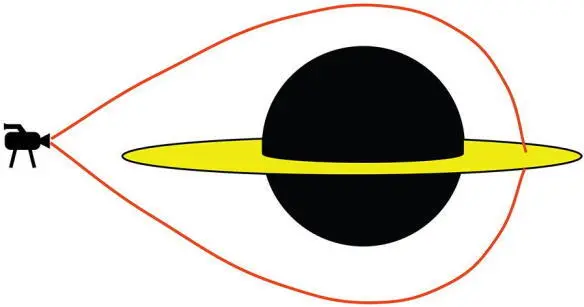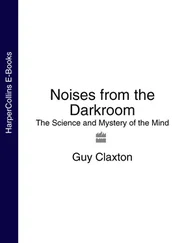Lynden-Bell, in 1969, speculated that quasars live at the centers of galaxies. We don’t see a quasar’s host galaxy, he said, because its light is so much fainter than the quasar’s light. The quasar drowns the galaxy out. In the decades since then, with improving technology, astronomers have found the galaxy’s light around many quasars, confirming Lynden-Bell’s speculation.
In those recent decades we also learned where most of the disk’s gas comes from. Occasionally a star strays so close to the quasar’s black hole that the hole’s tidal gravity (Chapter 4) tears the star apart. Much of the shredded star’s gas is captured by the black hole and forms an accretion disk, but some of the gas escapes.
In recent years, thanks to improving computer technology, astrophysicists simulated this. Figure 9.5 is from a recent simulation by James Guillochon, Enrico Ramirez-Ruiz, and Daniel Kasen (University of California at Santa Cruz) and Stephan Rosswog (University of Bremen). [22] I changed the size of the hole to that of Gargantua and the size of the star to that of a red giant, and changed the time markers in Figure 9.5 accordingly.
At time zero (not shown) the star was headed almost precisely toward the black hole and the hole’s tidal gravity was beginning to stretch the star toward the hole and squeeze it from the sides, as in Figure 6.1. Twelve hours later the star is strongly deformed and at the location shown in Figure 9.5. Over the next few hours, it swings around the hole along the blue gravitational-slingshot orbit and deforms further as shown. By twenty-four hours the star is flying apart; its own gravity can no longer hold it together.

Fig. 9.5. Tidal disruption of a red giant star by a black hole similar to Gargantua.
The star’s subsequent fate is shown in Figure 9.6, from a different simulation by James Guillochon together with Suvi Gezari (Johns Hopkins University). For a movie of this simulation, see http://hubblesite.org/newscenter/archive/releases/2012/18/video/a/.

Fig. 9.6. Subsequent fate of the star in Figure 9.5.
The top two images are shortly before the beginning and shortly after the end of Figure 9.5; I enlarged these two images tenfold compared to the others, to make the hole and the disrupting star visible.
As the whole set of images shows, over the subsequent several years much of the star’s matter is captured into orbit around the black hole, where it begins to form an accretion disk. And the remaining matter escapes from the hole’s gravitational pull along a streaming, jetlike trajectory.
Gargantua’s Accretion Disk and Missing Jet
A typical accretion disk and its jet emit radiation—X-rays, gamma rays, radio waves, and light—radiation so intense that it would fry any human nearby. To avoid frying, Christopher Nolan and Paul Franklin gave Gargantua an exceedingly anemic disk.
Now, “anemic” doesn’t mean anemic by human standards; just by the standards of typical quasars. Instead of being a hundred million degrees like a typical quasar’s disk, Gargantua’s disk is only a few thousand degrees, like the Sun’s surface, so it emits lots of light but little to no X-rays or gamma rays. With gas so cool, the atoms’ thermal motions are too slow to puff the disk up much. The disk is thin and nearly confined to Gargantua’s equatorial plane, with only a little puffing.
Disks like this might be common around black holes that have not torn a star apart in the past millions of years or more—that have not been “fed” in a long time. The magnetic field, originally confined by the disk’s plasma, may have largely leaked away. And the jet, previously powered by the magnetic field, may have died. Such is Gargantua’s disk: jetless and thin and relatively safe for humans. Relatively.
Gargantua’s disk looks quite different from the pictures of thin disks that you see on the web or in astrophysicists’ technical publications, because those pictures omit a key feature: the gravitational lensing of the disk by its black hole. Not so in Interstellar , where Chris insisted on visual accuracy.
Eugénie von Tunzelmann was charged with putting an accretion disk into Oliver James’ gravitational lensing computer code, the code I described in Chapter 8. As a first step, just to see what the lensing does, Eugénie inserted a disk that was truly infinitesimally thin and lay precisely in Gargantua’s equatorial plane. For this book she has provided a more pedagogical version of that disk, made of equally spaced color swatches (Inset in Figure 9.7).
If there had been no gravitational lensing, the disk would have looked like the inset. The lensing produced huge changes from this (body of Figure 9.7). You might have expected the back portion of the disk to be hidden behind the black hole. Not so. Instead, it is gravitationally lensed to produce two images, one above Gargantua and the other below; see Figure 9.8. Light rays emitted from the disk’s top face, behind Gargantua, travel up and over the hole to the camera, producing the disk image that wraps over the top of Gargantua’s shadow in Figure 9.7; and similarly for the disk image that wraps under the bottom of Gargantua’s shadow.

Fig. 9.7. An infinitesimally thin disk in Gargantua’s equatorial plane, gravitationally lensed by Gargantua’s warped space and time. Here Gargantua spins very fast. Inset : The disk in the absence of the black hole. [From Eugénie von Tunzelmann’s artistic team at Double Negative.]

Fig. 9.8. Light rays ( red ) bring to the camera images of the back part of the accretion disk, behind Gargantua: one image above the hole’s shadow, the other below the hole’s shadow.
Inside these primary images, we see thin secondary images of the disk, wrapping over and under the shadow, near the shadow’s edge. And if the picture were made much larger, you would see tertiary and higher-order images, closer and closer to the shadow.
Can you figure out why the lensed disk has the form you see? Why is the primary image wrapping under the shadow attached to the thin secondary image wrapping over it? Why are the paint swatches on the over-wrapping and under-wrapping images widened so greatly, and those on the sides squeezed?…
Gargantua’s space whirl (space moving toward us on the left and away on the right) distorts the disk images. It pushes the disk away from the shadow on the left and toward the shadow on the right, so the disk looks a bit lopsided. (Can you explain why?)
To get further insight, Eugénie von Tunzelmann and her team replaced their variant of the color-swatch disk (Figure 9.7) with a more realistic thin accretion disk: Figure 9.9. This was much more beautiful, but it raised problems. Chris did not want his mass audience to be confused by the lopsidedness of the disk and black-hole shadow, and the shadow’s flat left edge, and the complicated star-field patterns near that edge (discussed in Chapter 8). So he and Paul slowed Gargantua’s spin to 0.6 of the maximum, making these weirdnesses more modest. (Eugénie had already omitted the Doppler shift caused by the disk’s motion toward us on the left and away on the right. It would have made the disk far more lopsided: bright blue on the left and dim red on the right—totally confusing to a mass audience!)
Читать дальше
















